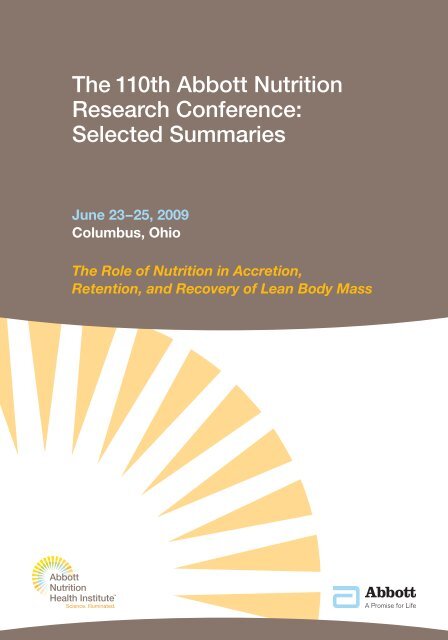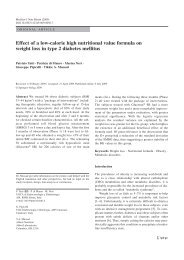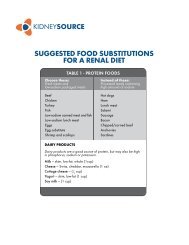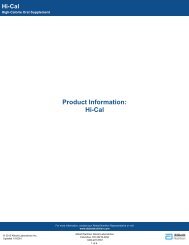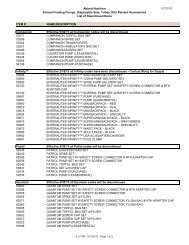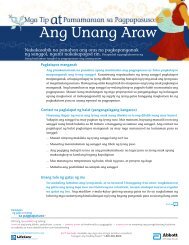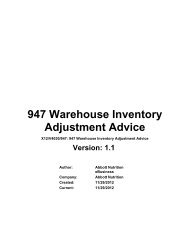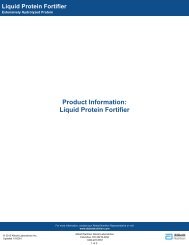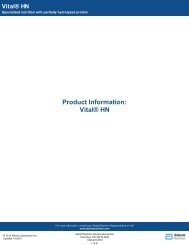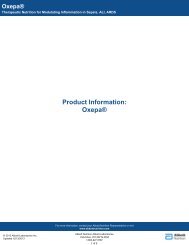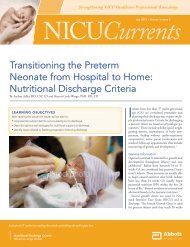The 110th Abbott Nutrition Research Conference: Selected ...
The 110th Abbott Nutrition Research Conference: Selected ...
The 110th Abbott Nutrition Research Conference: Selected ...
Create successful ePaper yourself
Turn your PDF publications into a flip-book with our unique Google optimized e-Paper software.
<strong>The</strong> Role of <strong>Nutrition</strong> in Accretion,Retention, and Recoveryof Lean Body MassGeneral EditorJudith Gussler, PhDClinEd Editorial Services©2009 <strong>Abbott</strong> <strong>Nutrition</strong> October 2009Printed in USALibrary of Congress Catalog Card No. xxxxxxxISBN xxx-x-xxx-xxxxx-xQuotation permitted if source acknowledged. Preferred form: Author and title, inGussler J (ed): <strong>The</strong> Role of <strong>Nutrition</strong> in Accretion, Retention, and Recovery of LeanBody Mass, Report of the <strong>110th</strong> <strong>Abbott</strong> <strong>Nutrition</strong> <strong>Research</strong> <strong>Conference</strong>: <strong>Selected</strong>Summaries. Columbus, Ohio: <strong>Abbott</strong> <strong>Nutrition</strong>, 2009, p 00.<strong>Abbott</strong> <strong>Nutrition</strong> is privileged to be associated with the production and provision ofthis information to members of the medical profession. Compilation and publicationof this information constitute neither approval nor endorsement by <strong>Abbott</strong> <strong>Nutrition</strong>or <strong>Abbott</strong> Laboratories of the opinions, inferences, findings, or conclusions stated orimplied by the authors in the presentations.<strong>The</strong> Role of <strong>Nutrition</strong> in Accretion,Retention, and Recoveryof Lean Body Mass<strong>The</strong> <strong>110th</strong> <strong>Abbott</strong> <strong>Nutrition</strong> <strong>Research</strong> <strong>Conference</strong> was held in Columbus, Ohio,on June 23–25, 2009. This Report contains summaries of presentations givenby the following contributors.Keynote AddressImportant Role of Skeletal Muscle in Overall HealthJohn E. Morley, MD, St. Louis University, St. Louis, MissouriDammert Professor of Gerontology and Director, Division of Geriatric Medicine,St. Louis Medical CenterDirector of the Geriatric <strong>Research</strong>, Education, and Clinical Center,St. Louis Veterans Affairs Medical CenterPresentation SummariesLean Body Mass Loss With AgeDouglas Paddon-Jones, PhD, University of Texas, GalvestonAssociate Professor, School of Health Professions and Departmentof Internal Medicine, University of Texas Medical Branch<strong>Nutrition</strong>, Muscle Mass, and Muscular Performance in Middle Age and BeyondCatherine Johnson, PhD, RD, LD, <strong>Abbott</strong> <strong>Nutrition</strong>, Columbus, OhioSenior <strong>Research</strong> Scientist, <strong>Abbott</strong> <strong>Nutrition</strong> Global <strong>Nutrition</strong> R&DMeasurement of Lean Body Mass Using CT ScansVickie Baracos, PhD, University of Alberta, CanadaChair, Alberta Cancer Foundation, Palliative MedicineProfessor, Department of Oncology, University of Alberta<strong>Abbott</strong> <strong>Nutrition</strong>Columbus, Ohio 43215Division of <strong>Abbott</strong> Laboratories, USAivv
ContentsAcronyms and AbbreviationsAcronyms and Abbreviations....................................................................................viiRole of Skeletal Muscle in Health...............................................................................1John E. Morley, MB, BCh, Saint Louis Universityand GRECC VA Medical Center, USALean Body Mass Loss With Age.................................................................................9Douglas Paddon-Jones, PhD, University of Texas, USA<strong>Nutrition</strong>, Muscle Mass, and Muscular Performance in Middle Age and Beyond.....15Catherine D. Johnson, PhD, RD, LD, <strong>Abbott</strong> <strong>Nutrition</strong> R&D, USAMeasurement of Lean Body Mass Using CT Scans.................................................21Vickie Baracos, PhD, University of Alberta, CanadaBMI .......body mass indexCRP ......C reactive proteinCT. .......computed tomographyEAAs. .....essential amino acidsHMB ......beta-hydroxy-beta-methylbutyrateIL-6 .......interleukin-6LBM ......lean body massMRI .......magnetic resonance imagingmTOR .....mammalian target of rapamycinNFκB .....nuclear factor κBPEM ......protein-energy malnutritionRDA ......recommended dietary allowanceRMR ......resting metabolic rateTNF. ......tumor necrosis factorvivii
MorleyRole of Skeletal Muscle in HealthJohn E. Morley, MB, BChSkeletal muscle plays a major role in health. Loss of skeletal muscle has beenassociated with weakness, fatigue, insulin resistance, falls, fear of falling,fractures, frailty, disability and death. All the components of frailty, as shownin Table 1, are related to skeletal muscle function. 1Table 1. Components of Frailty: <strong>The</strong> Cardiovascular Health Study. 1• <strong>The</strong> Cardiovascular Health Study enrolled 5,317 men and women≥65 years of age• Frailty defined as a clinical syndrome in which ≥3 of the followingwere present:– Unintentional weight loss (10 lbs in past year)– Exhaustion (self-reported)– Weakness (grip strength, lowest 20%)– Walking speed (15 feet, slowest 20%)– Low physical activity (kcal/week, lowest 20%)By this definition, nearly 7% of the participants were frailThis article summarizes the causes and outcomes of skeletal muscle loss, as well ascurrent recommended nutritional interventions in the treatment of muscle loss.Muscle disease related to aging can lead to loss of mass (sarcopenia), loss ofstrength, loss of power (dynapenia), fatigue, pain, and cramps. We need to recognize,however, that loss of strength and power are not directly related to loss of musclemass. In particular, we need to recognize that, with age, collagen infiltration into thetendons leads to loss of the angle of pennation (angle formed by pennate musclefibers with the line of action of the muscle), which results in a decline in the abilityto generate power. 2Weight loss can be caused by loss of muscle, fat, and/or bone. Whatever the type ofloss, multiple studies have shown that weight loss in people older than 60 years ofage increases mortality and morbidity, including in patients with diabetes mellitus. 3,41
Role of Skeletal Muscle in HealthMorleyOne study found that women older than 60 years of age who lost weight, intentionallyor unintentionally, had a 2.5 times greater risk for hip fracture than those who hadnot. 5 Because of the increased morbidity associated with weight loss in older adults,their risk for institutionalization also is increased.Prevalence of protein energy malnutrition (PEM) also is increased in populationswith certain diseases and in certain health care settings. For instance, PEM occursin 10% to 50% of people with diseases such as renal failure, chronic obstructivepulmonary disease, congestive heart disease, and HIV. Forty percent of people insubacute care are malnourished, as are 5% to 20% of those in nursing homes. 6<strong>The</strong> major causes of muscle wasting are anorexia, sarcopenia (age-associatedmuscle loss), and cachexia. Although these conditions all are characterized by lossof muscle, they differ in their impact on several anthropometric and laboratoryparameters, as shown in Table 2.Table 2. Comparison of Three Major Causes of Muscle WastingAnorexia Sarcopenia CachexiaBody mas -- - ---Fat free mas - -- ---Body fat --- 0 --Anorexia and AgingPhysiologic anorexia of aging can lead to weight loss. Age-related loss of appetiteand reduction of food intake are caused by changes in taste and smell, alterationsin the rate of filling of the antrum of the stomach, increased levels of the satiatinghormone cholecystokinin, and in males, high leptin levels stemming from decliningtestosterone. In older people, numerous reversible causes of weight loss occur, asshown in the mnemonic device in Table 3. 7 Depression is the most common causeof weight loss in older adults. 8Table 3. Causes of Weight LossMedicationsEmotions (depression)Alcoholism, anorexia, abuse (elder)Late life paranoiaSwallowing problemsOral problemsNosocomial infections, no money (poverty)RMR - - ++Physical activity - - -Food intake --- 0 --Proteolysis - + ++Cortisol +/- +/- ++Triglycerides 0 0 ++Wandering/dementiaHyperthyroidism, hypercalcemia, hypoandrenalismEnteric problems (malabsorption)Eating problems (eg, tremor)Low salt, low cholesterol dietShopping and meal preparation problems, stones (cholecystitis)Cytokines +/- + +++Anemia + 0 +++Insulin resistance 0 0 (+ in sarcopenic obesity) +RMR=resting metabolic rate+ and – symbols indicate the direction and strength of the impact of these conditionson the anthropometric and laboratory parameters listed at left23
Role of Skeletal Muscle in HealthMorleyClinicians can screen patients for anorexia with the Simplified <strong>Nutrition</strong>al AppetiteQuestionnaire (SNAQ), shown in Table 4. 9Table 4. Simplified <strong>Nutrition</strong>al Appetite Questionnaire (SNAQ)To Predict Weight Loss in Older People 91. My appetite isA. Very poorB. PoorC. AverageD. GoodE. Very good2. When I eatA. I feel full after eating only a few mouthfulsB. I feel full after eating about one third of a mealC. I feel full after eating over half a mealD. I feel full after eating most of the mealE. I hardly ever feel full3. Food tastesA. Very badB. BadC. AverageD. GoodE. Very good4. Normally I eatA. Less than one meal a dayB. One meal a dayC. Two meals a dayD. Three meals a dayE. More than 3 meals a dayInstructions: Complete the questionnaire by circling the correct answers and thentally the results based on the following numerical scale:A=1, B=2, C=3, D=4, E=5Scoring: If the score is less than 14, the risk of weight loss is significantPhysiologic anorexia of aging puts older adults at high risk for developing PEMwhen they develop either psychologic or physical disease processes. Screening foranorexia and early nutritional and/or pharmacologic intervention can reduce this risk.SarcopeniaNearly 3.6 million people in the United States have sarcopenia and are at increasedrisk for physical disability and frailty. In one study of 4504 adults 60 years of age andolder, those with severe sarcopenia had a two to three times greater likelihood offunctional impairment and disability than those without sarcopenia. 10 People whoare obese but who nonetheless are losing muscle mass (sarcopenic obesity) candevelop severe disability and have an increased death rate. 11Muscle is normally in a balanced state of anabolism and catabolism. While proteinsynthesis plays an important role in this process, repair of muscle cells requires theconstant generation of satellite cells. 12 Satellite cells are small mononucleated myogeniccells found in skeletal muscle fibers. <strong>The</strong>y are normally quiescent, but they proliferatein response to injury and help in repair and maintenance of skeletal muscle.<strong>Nutrition</strong> intervention in sarcopenia typically has focused on dietary supplementationwith protein and/or specific amino acids. While a total protein intake of 0.8 g/kg/dayis normally recommended, the International Cachexia Society recommends anintake of 1-1.5 g/kg/day for older people to prevent sarcopenia. Protein synthesis isbest maintained by a mixture of leucine-enriched essential amino acids. <strong>The</strong>se actnot only as building blocks for protein synthesis but also activate mammalian targetof rapamycin (mTOR), a serine/threonine protein kinase that drives protein synthesis.Essential amino acids act synergistically with exercise to increase muscle strength.Oral amino acids slow muscle loss that occurs with bed rest, reverses sarcopenia,and increases walk speed.Supplementation with other nutrients such as creatine and vitamin D have shownsome positive effects in people with sarcopenia. Creatine supplementation is shownto increase muscle power, if not mass, in older people, especially when combinedwith exercise. People with 25(OH) vitamin D levels below 30 ng/mL show declines inmuscle strength and increases in disability, falls, hip fracture, and mortality. 13 Levelsof 25(OH) vitamin D decline with aging. Vitamin D supplementation can decrease orreverse these changes.45
Role of Skeletal Muscle in HealthMorleyHormonal treatments also have been used with sarcopenic men. Testosteronereplacement increases muscle mass, strength, and function in hypogonadal males.Testosterone in combination with a protein supplement decreased hospitalizationsin people living in assisted living. 14 Selective androgen receptor molecules are beingdeveloped as potent anabolic steroids for use in treating sarcopenia.At present, treatment of sarcopenia and frailty consists of supplementation withessential amino acids and creatine, together with resistance exercise. Some studiesshow that giving essential amino acid and/or calorie supplements between mealsresults in optimum efficacy.CachexiaCachexia occurs in 10% to 35% of chronically ill older people. 15-17 <strong>The</strong> InternationalCachexia Society has defined cachexia as “a complex metabolic syndromeassociated with underlying illness and accompanied by loss of muscle with orwithout [loss of] fat mass. <strong>The</strong> prominent clinical feature of cachexia is weightloss.” 18 Table 5 describes the diagnostic criteria for cachexia.Table 5. Diagnostic Criteria for Cachexia• Weight loss (non-edema) of at least 5% in 12 months or less• BMI (
Role of Skeletal Muscle in Health6. Thomas DR, Zdrodowski CD, Wilson MM, et al: A prospective, randomizedclinical study of adjunctive peripheral parenteral nutrition in adult subacute carepatients. J Nutr Health Aging 2005;9:321-325.7. Morley JE, Silver AJ: <strong>Nutrition</strong>al issues in nursing home care. Ann Intern Med1995;123:850-859.8. Morley JE: Weight loss in the nursing home. J Am Med Dir Assoc 2007;8:201-204.9. Wilson MM, Thomas DR, Rubenstein LZ, et al: Appetite assessment: Simpleappetite questionnaire predicts weight loss in community-dwelling adults andnursing home residents. Am J Clin Nutr 2005;82:1074-1081.10. Janssen I, Heymsfield SB, Ross R: Low relative skeletal muscle mass(sarcopenia) in older persons is associated with functional impairment andphysical disability. J Am Geriatr Soc 2002;50:889-896.11. Baumgartner RN, Wayne SJ, Waters DL, et al: Sarcopenic obesity predictsinstrumental activities of daily living disability in the elderly. Obes Res2004;12:1995-2004.12. Morley JE: Weight loss in older persons: New therapeutic approaches. CurrPharm Des 2007;13:3637-3647.13. Brose A, Parise G, Tarnopolsky MA: Creatine supplementation enhancesisometric strength and body composition improvements following strengthexercise training in older adults. J Gerontol A Biol Sci Med Sci 2003;58:11-19.14. Chapman IM, Visvanathan R, Hammand AJ, et al: Effect of testosterone anda nutritional supplement, alone and in combination, on hospital admission inundernourished older men and women. Am J Clin Nutr 2009;89:880-889.15. Yeh SS, Blackwood K, Schuster MW: <strong>The</strong> cytokine basis of cachexia and itstreatment: Are they ready for prime time? J Am Med Dir Assoc 2008;9:219-236.16. Morley JE, Anker SD, Evans WJ: Cachexia and aging: An update based on theFourth International Cachexia Meeting. J Nutr Health Aging 2009;13:47-55.17. Morley JE, Thomas DR, Wilson MM: Cachexia: Pathophysiology and clinicalrelevance. Am J Clin Nutr 2006;83:735-743.18. Evans WJ, Morley JE, Argilés J, et al: Cachexia: A new definition. Clin Nutr2008;27:793-799.19. Gissi-HF Investigators, Tavazzi L, Maggioni A, Marchioli R: Effect of n-3polyunsaturated fatty acids in patients with chronic heart failure (the GISSI-HFtrial): A randomized, double-blind, placebo-controlled trial. Lancet 2008;372:1223-1230.Lean Body Mass Loss With AgeDouglas Paddon-Jones, PhDSarcopenia is an age-related, multifactorial process characterized by theprogressive loss of lean tissue mass. <strong>The</strong> onset of sarcopenia is insidious,but its progression may be accelerated by physical inactivity and poornutrition. <strong>Research</strong> continues to focus on the mechanisms contributing to sarcopenia,including changes in protein metabolism and cell signaling, voluntary or imposedreductions in physical activity, malnutrition, and reduced anabolic efficiency toprotein ingestion.Elderly individuals are at increased risk of becoming physically incapacitatedor placed on bed rest for an extended period. <strong>The</strong> loss of lean body mass isdramatically increased during inactivity and is driven by a chronic imbalancebetween muscle protein synthesis and breakdown and facilitated by decreasedactivation of nutrient signaling pathway. 1-3 In recent studies examining changes inprotein synthesis and muscle mass in healthy adults subjected to bed rest, oldersubjects experienced an approximate three-fold greater loss of lean leg musclemass compared to a cohort of younger individuals confined to bed for 28 days(Figs 1 and 2). 2,4Inactivity and Aging MuscleLoss of lean leg mass (g)2500-250-500-750-1000-1500-2000Healthy Young28 Days InactivityHealthy Elders10 Days Inactivity2% total lean leg mass 10% total lean leg mass3 times moremuscle loss1/3 the timeAll volunteersconsumed theRDA for proteinFig 1. After 10 days of inactivity, older healthy subjects experienced an approximatelythree-fold greater loss of lean leg muscle mass than a cohort of younger individuals confinedto bed for 28 days. 2,4 (1000 g=2.2 lb muscle loss)89
Lean Body Mass Loss With AgeMuscle Loss in Hospitalized EldersLoss of lean leg mass (g)2500-250-500-750-1000-1500-2000Healthy Young28 Days InactivityHealthy Elders10 Days InactivityElderly Inpatients3 Days Hospitalization2% total lean leg mass 10% total lean leg mass 10+ % total lean leg massProtein Synthesis (%/h)0.140.120.10.080.060.040.02050% increaseFasting*30 g protein* Young ElderlyFig 2. After 3 days of hospitalization, elderly inpatients lost approximately the same amount oflean leg muscle mass as healthy older healthy subjects experienced in 10 days of inactivity—approximately three-fold greater loss of lean leg muscle mass than a younger cohort confinedto bed for 28 days. 2,4General consensus exists that a moderate-to-large serving of protein or amino acidsincreases muscle protein synthesis similarly in both young and elderly. 4-12 Unlikeearlier proof of concept studies using free-form amino acid supplements, severalrecent studies have adopted a more practical approach and sought to examinethe ability of protein-rich foods (eg, milk and beef) to stimulate protein anabolism.<strong>The</strong>se studies are important as they more closely reflect responses to actual dietarypractices and provide information on how meal choices may influence accrual ofmuscle mass and ultimately functional capacity. In one study directly comparingyoung and elderly, Symons et al 13 reported that a moderate 113 g (≈4 oz) servingof an intact protein (ie, lean beef) contains sufficient essential amino acids (EAAs)(30 g total; ≈12 g EAAs) to increase mixed-muscle protein synthesis by 50% in bothyoung and elderly men and women (Fig 3).Fig 3. Aging does not impair the ability to increase muscle protein synthesis followingingestion of 113 g of lean beef (30 g protein). h=hour<strong>The</strong> adequacy of the recommended dietary allowance (RDA) for protein has recentlybeen the subject of renewed debate. 14-19 <strong>The</strong> current recommendation for proteinintake for adults is 0.8 g/kg –1 /day –1 . While a modest increase in protein intake beyond0.8 g/kg–1/day–1 is likely to be beneficial for many elders, there is a greater need tospecifically examine the dose and distribution of protein across each meal. For a75-kg individual, the RDA represents 60-g protein/day, or if distributed evenly acrossthree meals, 20-g protein/meal. A 20 g serving of most protein contains 5 g to 8 g ofEAAs, which are primarily responsible for stimulating muscle protein synthesis. 101011
Lean Body Mass Loss With AgeThis is important because aging appears to be associated with an inability ofskeletal muscle to respond to low doses of protein (
Lean Body Mass Loss With AgeJohnson6. Paddon-Jones D, Sheffield-Moore M, Katsanos CS, et al: Differential stimulationof muscle protein synthesis in elderly humans following isocaloric ingestion ofamino acids or whey protein. Exp Gerontol 2006;41:215-219.7. Paddon-Jones D, Sheffield-Moore M, Zhang XJ, et al: Amino acid ingestionimproves muscle protein synthesis in the young and elderly. Am J PhysiolEndocrinol Metab 2004;286:E321-E328.8. Paddon-Jones D, Wolfe RR, Ferrando AA: Amino acid supplementation forreversing bed rest and steroid myopathies. J Nutr 2005;135:1809S-1812S.9. Volpi E, Ferrando AA, Yeckel CW, et al: Exogenous amino acids stimulate netmuscle protein synthesis in the elderly. J Clin Invest 1998;101:2000-2007.10. Volpi E, Kobayashi H, Sheffield-Moore M, et al: Essential amino acids areprimarily responsible for the amino acid stimulation of muscle protein anabolismin healthy elderly adults. Am J Clin Nutr 2003;78:250-258.11. Volpi E, Lucidi P, Cruciani G, et al: Contribution of amino acids and insulin toprotein anabolism during meal absorption. Diabetes 1996;45:1245-1252.12. Volpi E, Mittendorfer B, Wolf SE, Wolfe RR: Oral amino acids stimulate muscleprotein anabolism in the elderly despite higher first-pass splanchnic extraction.Am J Physiol Endocrinol 1999;277:E513-E520.13. Symons TB, Schutzler SE, Cocke TFL, et al: Aging does not impair the anabolicresponse to a protein-rich meal. Am J Clin Nutr 2007;86:451-456.14. Campbell WW, Trappe TA, Wolfe RR, Evans WJ: <strong>The</strong> recommended dietaryallowance for protein may not be adequate for older people to maintain skeletalmuscle. J Gerontol A Biol Sci Med Sci 2001;56:M373-M380.15. Wolfe RR: <strong>The</strong> underappreciated role of muscle in health and disease. Am J ClinNutr 2006;84:475-482.16. Wolfe RR, Miller SL: <strong>The</strong> recommended dietary allowance of protein:A misunderstood concept. JAMA 2008;299:2891-2893.17. Leidy HJ, Carnell NS, Mattes RD, Campbell WW: Higher protein intake preserveslean mass and satiety with weight loss in pre-obese and obese women. Obesity(Silver Spring) 2007;15:421-429.18. Thalacker-Mercer AE, Fleet JC, Craig BA, et al: Inadequate protein intake affectsskeletal muscle transcript profiles in older humans. Am J Clin Nutr 2007;85:1344-1352.19. Millward DJ, Layman DK, Tomé D, Schaafsma G: Protein quality assessment:Impact of expanding understanding of protein and amino acid needs for optimalhealth. Am J Clin Nutr 2008;87:1576S-1581S.20. Katsanos CS, Kobayashi H, Sheffield-Moore M, et al: Aging is associated withdiminished accretion of muscle proteins after the ingestion of a small bolus ofessential amino acids. Am J Clin Nutr 2005;82:1065-1073.21. Symons TB, Sheffield-Moore M, Wolfe RR, Paddon-Jones D: A moderate servingof high-quality protein maximally stimulates skeletal muscle protein synthesis inyoung and elderly subjects. J Am Diet Assoc 2009;109:1582-1586.<strong>Nutrition</strong>, Muscle Mass, and MuscularPerformance in Middle Age and BeyondCatherine Johnson, PhD, RD, LDAging is associated with many changes in body composition, includingreduction of lean body mass with a concomitant increase in fat mass. 1<strong>The</strong>se changes often have a negative impact on overall health andfunctional capacity.Sarcopenia is the degenerative loss of skeletal muscle and strength, beginning asearly as age 30, and accelerating with advancing age. Advancing sarcopenia isassociated with increased risk of fall and fractures, decreased ability to completeactivities of daily living, and increase in fatigue, which all lead to dependencyand disability. 2A lifestyle behavior that positively affects muscle mass is consumption of dietaryprotein. Longitudinal studies have shown that older people who consume higheramounts of protein lose less lean muscle mass over 3 years than those who eatlower amounts (eg, 91 g/day vs 57 g/day). 3 Protein quality, quantity, and timingof consumption throughout the day and in conjunction with physical activity areall important to maintenance of muscle mass. Protein sources of high biologicvalue, namely those from animal sources, will provide the highest concentrationof branched-chain amino acids such as leucine, which stimulate muscleprotein synthesis. 4,5Milk proteins, whey and casein, are shown to stimulate muscle protein synthesis.Both are high-quality proteins and should be consumed daily. However, theyproduce a different response in young people than they do in older people. Whey,for instance, is digested faster than casein and produces a relatively better responseon protein balance in older people. Casein has the opposite effect and has a betterresponse in younger people. 6,71415
<strong>Nutrition</strong>, Muscle Mass, and Muscular Performancein Middle Age and BeyondJohnson<strong>The</strong> goal of protein consumption and lean body mass gains is to optimize muscleprotein synthesis. <strong>The</strong> quantity of essential amino acids (EAAs) is critical to elicitmuscle protein synthesis. Elderly people may require 20 g to 30 g of high-qualityprotein containing at least 8 g of EAAs, including leucine, three or four times a day. 4,8Another strategy to maximize muscle protein synthesis is consumption of protein-richmeals more frequently, every 2 or 3 hours. 9HMB is shown to decrease protein degradation by downregulation of the ubiquitinproteasomesystem (Fig 2). 14 It has also been shown to stimulate protein synthesisby activation of mammalian target of rapamycin (mTOR), a serine/threonineprotein kinase. 15,16Leucine is the primary amino acid regulator that “turns on” protein synthesis inthe cells, signaling that quality protein is available for protein synthesis. <strong>Research</strong>shows that adding leucine to a meal that combines carbohydrate and protein isnot necessary to get a response in protein synthesis in younger people, but it isnecessary to get the same response in older people. 10 <strong>The</strong>se results suggest thatthe protein-synthesis response is blunted in older people when a meal combinescarbohydrate with protein. Reducing simple carbohydrates may be an advantageousstrategy to maximize protein synthesis, because this also is been shown to reduceloss of lean tissue for people with a negative caloric intake. 9-12A minor metabolite of L-leucine, beta-hydroxy-beta-methyl butyrate (HMB), is aprecursor of cholesterol synthesis in skeletal muscle and plays a role in the controlof protein homeostasis (Fig 1). 13Muscle CellMembraneNFB may helpregulate generalinflammationDown-regulation ofubiquitin-proteosomesystemNFBProteinDegradationHMBHMBInsulinmTORProteinSynthesisActivationof ribosomalassemblyLeucineDe novocholesterolsynthesisMuscle cellmembranestrengthenedHMBProteinsynthesisenhancedFig 1. Sources and functions of HMB. 13Glucose &insulinsensitivity?ImmuneenhancementProteindegradationreducedChemical structureof HMBCH 3ICH 3 C-CH -COOIOHNaturally found insmall amounts in some foods(eg, catfish, grapefruit, alfalfa)Commercially producedby organic chemical synthesisFig 2. Role of HMB in protein synthesis and degradation. NFκB=nuclear factor κBOral administration of HMB is strongly associated with increased strength and leanbody mass (LBM) and with decreased fat mass in young- to middle-aged peoplewhen combined with resistance exercise. HMB has also been shown to haveclinical benefit in a number of muscle wasting/cachectic conditions and in limbimmobilization. 14,17,18 <strong>The</strong>se mechanisms appear to be relevant to older people, andclinical studies have demonstrated decreases in body fat percentage, gains inlower- and upper-body strength, increases in limb circumference, leg and handgripstrength, and increases in “get-up-and-go” performance with HMB. 13,19,20 <strong>The</strong>get-up-and-go functionality assessment involves measuring the time it takes aperson to rise from a chair, walk a specified distance, and then return to the chair.Fig 3 shows the improvements in functionality that resulted when 50 elderly womenwere supplemented with 2 g HMB, along with arginine and lysine, daily for 12 weeks. 191617
<strong>Nutrition</strong>, Muscle Mass, and Muscular Performancein Middle Age and BeyondJohnsonFig 3 shows the improvements in functionality that resulted when 50 elderly womenwere supplemented with 2 g HMB, along with arginine and lysine, daily for 12 weeks. 19Start+12 weeksStart+12 weeks4 6 8 10 12Get-up-and-go time (sec) Control 1% HMB+ 17%P=0.002Fig 3. Changes in functionality after 12 weeks of supplementation with HMB+ (HMB, arginine,and lysine) compared to controls. 19 sec=secondsAfter 12 weeks of supplementation, the “get-up-and-go” functionality test resultsimproved by 17% in the experimental group (2.3 +/- 0.5 seconds), but did notchange in the placebo group (P=0.002). Improved functionality also was reflectedin increased limb circumference, leg strength, and handgrip strength (each P
<strong>Nutrition</strong>, Muscle Mass, and Muscular Performancein Middle Age and BeyondBaracos11. Koopman R, Wagenmakers AJ, Manders RJ, et al: Combined ingestion ofprotein and free leucine with carbohydrate increases postexercise muscleprotein synthesis in vivo in male subjects. Am J Physiol Endocrinol Metab2005;288:E645-E653.12. Layman DK: <strong>The</strong> role of leucine in weight loss diets and glucose homeostasis.J Nutr 2003;133:261S-267S.13. Wilson GJ, Wilson JM, Manninen AH: Effects of beta-hydroxy-beta-methylbutyrate(HMB) on exercise performance and body composition across varying levels ofage, sex, and training experience: A review. Nutr Metab (Lond) 2008;5:1.14. Smith HJ, Mukerji P, Tisdale MJ: Attenuation of proteasome-induced proteolysisin skeletal muscle by beta-hydroxy-beta-methylbutyrate in cancer-inducedmuscle loss. Cancer Res 2005;65:277-283.15. Kornasio R, Riederer I, Butler-Browne G, et al: Beta-hydroxy-beta-methylbutyrate(HMB) stimulates myogenic cell proliferation, differentiation and survival via theMAPK/ERK and PI3K/Akt pathways. Biochim Biophys Acta 2009;1793:755-763.16. Eley HL, Russell ST, Tisdale MJ: Attenuation of depression of muscle proteinsynthesis induced by lipolysaccharide, tumor necrosis factor, and angiotensin IIby beta-hydroxy-beta-methylbutyrate. Am J Physiol Endocrinol Metab2008;295:E1409-E1416.17. Hsieh LC, Chien SL, Huang MS, et al: Anti-inflammatory and anticataboliceffects of short-term beta-hydroxy-beta-methylbutyrate supplementation inchronic obstructive pulmonary disease patients in intensive care unit. AsiaPac J Clin Nutr 2006;15:544-550.18. May PE, Barber A, D’Olimpio JT, et al: Reversal of cancer-related wasting usingoral supplementation with a combination of beta-hydroxy-beta-methylbutyrate,arginine, and glutamine. Am J Surg 2002;183:471-479.19. Flakoll P, Sharp R, Baier S, et al: Effect of beta-hydroxy-beta-methylbutyrate,arginine, and lysine supplementation on strength, functionality, bodycomposition, and protein metabolism in elderly women. <strong>Nutrition</strong> 2004;20:445-451.20. Vukovich MD, Stubbs NB, Bohlken RM, et al. Body composition in 70-year oldadults responds to dietary beta-hydroxy-beta-methylbutyrate (HMB) similarly tothat of young adults. J Nutr 2001;131:2049-1935.21. Biolo G, Maggi SP, Williams BD, et al: Increased rates of muscle protein turnoverand amino acid transport after resistance exercise in humans. Am J Physiol1995;268:E514-E520.22. Biolo G, Tipton KD, Klein S, Wolfe R: An abundant supply of amino acidsenhances the metabolic effect of exercise on muscle protein. Am J Physiol1997;273:E122-E129.23. Esmarck B, Andersen JL, Olsen S, et al: Timing of postexercise protein intakeis important for muscle hypertrophy with resistance training in elderly humans.J Physiol 2001;535:301-311.Measurement of Lean Body MassUsing CT ScansVickie Baracos, PhDBody Mass Index (BMI) and Weight Loss: ConventionalElements of How Cachexia and <strong>Nutrition</strong>al Status HaveBeen Defined in Cancer PatientsOur understanding of cancer cachexia in the past has focused on losses ofbody weight. Since ancient times, the relationship between loss of bodyweight over time and poor cancer outcomes has been known. Even thoughmeasures such as loss of lean body mass may be better predictors of patientoutcomes, weight loss remains firmly entrenched as a criterion for identificationof malnutrition and cachexia. Body weight loss, for instance, still is used as a majorcriterion of inclusion and also as a principal endpoint in randomized clinical trialsfor various forms of cachexia treatment, including nutritional support. In a reviewof 55 clinical trials looking at the effect of appetite stimulants on cancer cachexia,Yavuzsen et al 1 reported that 91% of studies examined used overall body weightchange as an outcome.Progressive loss of weight is conventionally viewed as culminating in a cachexic(ie, emaciated) state. Current demographics of cancer patients, however, areprogressively affected by increasing rates of obesity, as well as by an increasingprevalence of cancer in obese people. As a result, patients with advanced diseaseare reported to have a high prevalence of obesity in spite of ongoing weight losses. 2Despite considerable weight loss in some of these patients, the classic image ofcachexia (ie, emaciation) is becoming less common. We conducted population-basedprofiling of BMI and weight loss history in a cohort (n=2695) of gastrointestinaltracts. Patients were newly referred to medical oncology clinics in a regional cancercenter. A computerized database of all cancer cases in the province (Alberta CancerRegistry) was used to capture disease site and morphology, along with biological,2021
Measurement of Lean Body Mass Using CT ScansBaracosclinical, and demographic information. Analysis of BMI reveals an average BMI>26 kg/m 2 and a preponderance of overweight and obese patients, with only 5%presenting with a BMI
Measurement of Lean Body Mass Using CT ScansBaracosCT is considered a gold standard method used to assess body composition 14 ;however, its use in noncancer populations is limited.Cancer patients undergo frequent routine scans for diagnosis and to monitordisease progression. Although these patients are routinely evaluated by highresolution diagnostic imaging, the information content of these images is barelyexploited, in part owing to lack of deployment of relevant methods and concepts ina cancer care setting. We have proposed the opportunistic use of these high-qualityimages, which are readily available in the medical record of these patients, to provideaccurate and practical studies of body composition across the cancer trajectory. 15<strong>The</strong>se images are a considerable resource and are now in many institutions storedand accessible in a digitized format. For example, our large cohort of patients withsolid tumors of the lung and gastrointestinal tract typically undergo imaging fourtimes a year during active treatment. An extensive reliance on diagnostic imaginggives specialists in cancer care an unprecedented ability to evaluate their patients’body composition, including repeated measures over time.<strong>The</strong> premise of CT scans for body composition research has been described indetail elsewhere. 14,15 It is important to note that these methods are accessible. Imageanalysis software is commercially available, and the quantification can be done byany qualified person with appropriate knowledge of human anatomy, the nature ofthe images, and the capacities of the software.Diagnostic images taken in cancer care do not usually encompass the whole body;this requires that patients be evaluated at a standardized location. Specific skeletallandmarks in the lumbar region appear in a majority of work in non-malignantdisease as well as in cancer. 2,15 As illustrated in Fig 1, this region contains visceral,subcutaneous, and intermuscular adipose tissue, psoas and paraspinal muscles(erector spinae and quadratus lumborum) as well as transversus abdominus, externaland internal oblique abdominals, and rectus abdominus. Since the cross-sectionalareas of tissues in single images in the lumbar area are strong correlates of wholebodyadipose tissue, muscle, and lean tissue mass, 15-17 we make use of the 3rdlumbar vertebra (L3) in our characterization of cancer patients. Individuals may becompared directly on this basis; however, these quantities may be translated toapproximate whole body tissue masses using regression equations from earlierwork. 15-17 Specific tissues are identified based on their anatomical features (Fig 1)and then demarcated and quantified (Fig 2) based on pre-established thresholds ofHounsfield units (units of radiation attenuation) using commercially available imaginganalysis software.Cross-sectional areas (cm 2 ) are computed automatically by the program oncethe desired tissues are demarcated. Demarcated images (Fig 2) illustrate bodycomposition changes in a lung cancer patient over time; this person lost skeletalmuscle during progressive disease.Fig 2. Skeletal muscle loss in a patient with lung cancer. Segmented CT images for a malelung cancer patient at two separate timepoints. Number 1 was taken 390 days before death,and 2 was taken 58 days before death. Segmented tissues of interest: n is skeletal muscle,n is visceral adipose tissue, n is subcutaneous adipose tissue, and n is intramuscular adiposetissue. During this 332 day period, skeletal muscle area decreased from 173 cm 2 to 86.7 cm 2 .ConclusionsCurrent demographics of weight and body composition suggest a need toreconceptualize cancer cachexia. Substantial depletion of skeletal muscle is awidespread abnormality of body composition in patients with advanced solidtumors, which is present in people at any BMI and strongly related to outcome. Validand convenient approaches for determining muscularity are required to evaluate thisfeature in cancer patients, and the secondary analysis of CT images is an accessiblemeans of making this evaluation.References1. Yavuzsen T, Davis MP, Walsh D, et al: Systematic review of the treatment ofcancer-associated anorexia and weight loss. J Clin Oncol 2005;23:8500-8511.2. Prado CM, Lieffers JR, McCargar LJ, et al: Prevalence and clinical implicationsof sarcopenic obesity in patients with solid tumours of the respiratory andgastrointestinal tracts: A population-based study. Lancet Oncol 2008;9:629-635.3. Baumgartner RN, Koehler KM, Gallagher D, et al: Epidemiology of sarcopeniaamong the elderly in New Mexico. Am J Epidemiol 1998;147:755-763.24 25
Measurement of Lean Body Mass Using CT Scans4. Janssen I, Heymsfield SB, Ross R: Low relative skeletal muscle mass(sarcopenia) in older persons is associated with functional impairment andphysical disability. J Am Geriatr Soc 2002;50:889-896.5. Pichard C, Kyle UG, Morabia A, et al: <strong>Nutrition</strong>al assessment: Lean body massdepletion at hospital admission is associated with an increased length of stay.Am J Clin Nutr 2004;79:613-618.6. Cosqueric G, Sebag A, Ducolombier C, et al: Sarcopenia is predictive ofnosocomial infection in care of the elderly. Br J Nutr 2006;96:895-901.7. Metter EJ, Talbot LA, Schrager M, Conwit R: Skeletal muscle strength as apredictor of all-cause mortality in healthy men. J Gerontol A Biol Sci Med Sci2002;57:B359-B365.8. Baumgartner RN: Body composition in healthy aging. Ann N Y Acad Sci2000;904:437-448.9. Zamboni M, Mazzali G, Fantin F, et al: Sarcopenic obesity: A new categoryof obesity in the elderly. Nutr Metab Cardiovasc Dis 2008;18:388-395.10. Roubenoff R: Sarcopenic obesity: Does muscle loss cause fat gain? Lessonsfrom rheumatoid arthritis and osteoarthritis. Ann N Y Acad Sci 2000;904:553-557.11. Bouchard DR, Dionne IJ, Brochu M: Sarcopenic/obesity and physical capacityin older men and women: Data from the <strong>Nutrition</strong> as a Determinant of SuccessfulAging (NuAge)-the Quebec Longitudinal Study. Obesity (Silver Spring). 2009.DOI:10.1038/oby.2009.109 [Epub ahead of print].12. Rolland Y, Lauwers-Cances V, Cristini C, et al: Difficulties with physical functionassociated with obesity, sarcopenia, and sarcopenic-obesity in communitydwellingelderly women: <strong>The</strong> EPIDOS (EPIDemiologie de l’OSteoporose) Study.Am J Clin Nutr 2009;89:1895-1900.13. Evans WJ, Morley JE, Argilés J, et al : Cachexia: A new definition. Clin Nutr2008;27:793-799.14. Ross R, Janssen I: Computed tomography and magnetic resonance imaging,in Heymsfield S, Lohman T, Wang Z, Going S (eds): Human Body Composition,ed 2. Champaign, Ill: Human Kinetics, 2005, p 523.15. Mourtzakis M, Prado CMM, Lieffers JR, et al : A practical and precise approachto quantification of body composition in cancer patients using computedtomography images acquired during routine care. Appl Physiol Nutr Metab2008;33:997-1006.16. Shen W, Punyanitya M, Wang Z, et al: Visceral adipose tissue: Relations betweensingle-slice areas and total volume. Am J Clin Nutr 2004;80:271-278.17. Shen W, Punyanitya M, Wang Z, et al: Total body skeletal muscle and adiposetissue volumes: Estimation from a single abdominal cross-sectional image.J Appl Physiol 2004;97:2333-2338.2627
© 2009 <strong>Abbott</strong> Laboratories Inc.XXXXX/OCTOBER 2009 LITHO IN USAwww.abbottnutrition.com<strong>Abbott</strong> <strong>Nutrition</strong><strong>Abbott</strong> LaboratoriesColumbus, Ohio 43219-3034 USA


